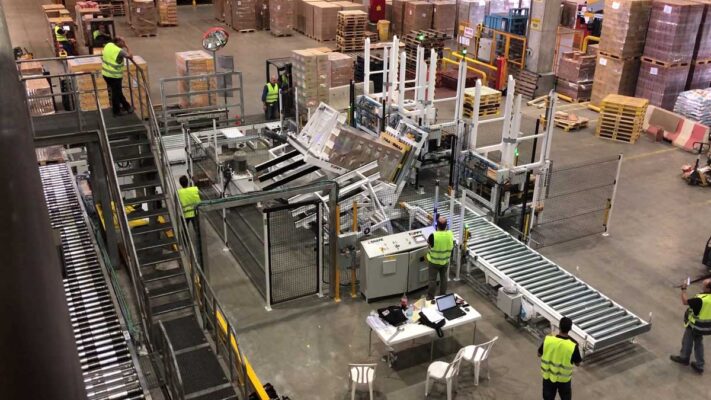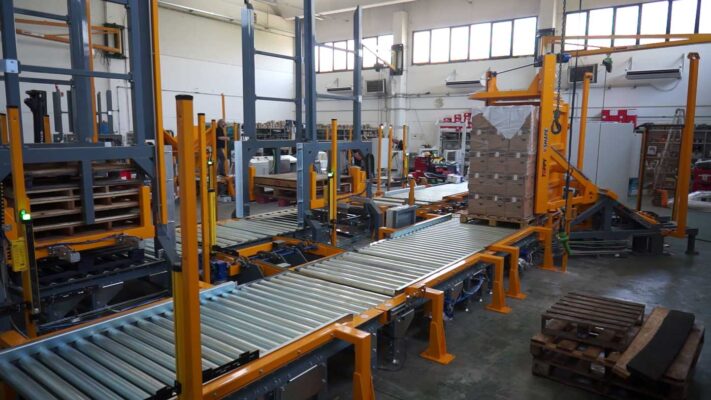Every manufacturing industry needs a warehouse that will function as a sophisticated engine for generating revenue for the company.
Warehouse operation is carried out by a few individuals who are going to operate several warehouse equipment needed in many different work processes of the warehouse. Choosing the right equipment can help increase the efficiency of the warehouse.
Therefore, the company must select the right warehouse machinery and install them so that it can help the company in saving a lot of manual effort, time and money as well.
Let us discuss in this post, a few important types of warehouse machinery, and equipment that can make a lot of difference in the productivity and efficiency of any warehouse.

Pallet Inverters as a warehouse machinery
A pallet inverter is one of the important machines used in the warehouse that is meant for turning pallets upside down. Why this process is so important? That is because pallet inverters can help in preventing any kind of damage to your products that is being stored on the pallets.
In addition to that, pallet inverters can also help in improving the efficiency of the operations of a warehouse in many ways. Let us try to understand a few benefits offered by the use of pallet inverters.
-
Reduced product damage
A pallet inverter will flip over the product that is on the pallet and as a result, it can help reduce any kind of damage to the product carried by the pallet. The products will remain safe from any bumps and some other impact.
-
Improved efficiency
Another benefit is that this pallet inverter will improve the efficiency of the operation by reducing the time taken for loading or unloading the products. Besides, it can also help in your inventory management.
-
Reduced labor costs
By using a pallet inverter several operations can be automated and as a result, you will need lesser manpower to do a few important functions. This may reduce the labor costs.
-
Better utilization of space
Installing pallet inverters will help you to manage the space of your warehouse much better. You can also reduce the damage to your products that can cause because of the crowding of many products in a line.
-
Improves safety with warehouse machinery
The pallet inverter can also work as a load straightener because if any poorly stacked or tilted products are on the line then they can always fall down and cause certain injuries to workers.
-
Load transfer becomes easier
By using a pallet inverter, the transfer of your raw materials to certain hygienic plastic pallets will become very easy.
-
Efficient recovery of damaged pallets
Damaged pallets are usually a concern in the line that can become an operational hazard. With this, you can easily recover those damaged pallets and your work system becomes more efficient.
Storage System as a warehouse machinery
There are two types of storage systems adopted as warehouse machinery:
- Bulk: In case of bulk storage all the pallets will be simply kept on the floor
- Rack: In rack storage, pallets are going to be stacked on racks for taking benefit of higher ceiling space.
The following are a few types of equipment used as warehouse machinery:
- Wire decking and pallet racks
- Heavy-duty shelving
- Cantilevered racks
- Push back racking
- Reel racks
- Pallet flow racking
- Drive-in racking
Utilizing any high-density systems, it is possible to maximize the utilization of space and as a result, there will not be an additional requirement for extra storage facilities.
Whether these high-density systems are suitable depends on FIFO (first-in, first-out) inventory systems. A form of the aisle that limits lift mobility is known as a narrow aisle (NA) or very narrow aisle (VNA) region.
For a standard counterbalanced lift truck to turn around, the aisle must be at least 11 feet wide. Three-wheel pallet jacks are frequently utilized in warehouses due to their improved ability to navigate in small spaces.


Handling and Transfer
The movement of products is one of the most important activities in any warehouse. The following types of equipment are in use for that purpose:
- Pallet jacks
- Hand trucks
- Lift trucks
- Scissor lifts
- Stackers
Also, there are a few other types of lifts and trucks that are in use in the warehouse for moving material to various locations of a warehouse.
- There are unique designs like narrow-aisle forklifts suitable for high-density storehouse plans. Reach trucks that are guided by wire or rail are sometimes used in warehouses with small aisles to maximize storage capacity.
- Automated storage and retrieval, or AS&R, can reduce the need for manpower but at a price. Such systems commonly use vertical or horizontal carousels for stock storage.
- Paper rolls and storage barrels are two examples of unpalletized commodities that can be handled with specialized forklift attachments.
In many warehouses, you will see conveyor systems of many different types are installed. Such conveyors serve to transport any picked items. There are a few gravity and roller conveyors, and also skate-wheel conveyors.
In certain warehouses temporary conveyors are also used that can be quite flexible and can be utilized under certain special occasions.

Conveyor systems as warehouse machinery
Depending upon how much load the conveyor can normally carry during the material transport.
-
Capacity at maximum load
This is expressed with load capacity/unit length.
-
Conveyor belt system speed
Usually, the belt speed is expressed in feet per minute in the belt conveyor. For powered roller conveyors, it is expressed in terms of linear velocity per unit of a carton, box, or other objects that will travel.
-
Throughput in warehouse machinery
It is expressed as a volume/unit of time, like cubic feet/minute.
-
Configuration of the frame
The configuration form of your conveyor can be straight, curved, z-frames, or any other form.
-
Driving directions
On conveyor systems, there are different drive directions:
- Head or end drive: Located on the conveyor’s discharge side
- Center drive: Located below the system.
These are the basic equipment that can be found as warehouse machinery. Many companies are available that can supply equipment as per the customization needed in any warehouse.
